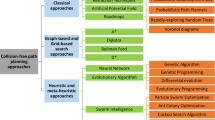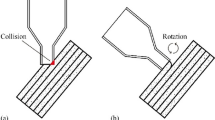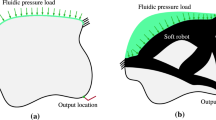Abstract
In the bolt looseness detection task of the locomotive system, the robot could be used to highly improve the working efficiency and reliability, but faces the complex static obstacles while planning the path for the robotic motion. In this paper, a path optimization technique is proposed to obtain an optimal path with obstacle avoidance for a redundant robot in the static complicated environment. There are three main contributions in this technique. The first is the solving of the inverse kinematics problem for a redundant robot based on the screw theory and the geometric description, which is general to all robots with rotational joints. The second is the modeling of the spatial constraint, where the pseudo distance is defined based on the plane description of the obstacles and calculated using the spatial analytic geometry knowledge. The third is the presentation of the whole path-planning framework based on the above two contributions, which could largely improve the generality of the presented technique. In this framework, the minimum-time path could be obtained while guaranteeing both the motion stability and obstacle avoidance. Moreover, a real setting that includes an obstacle environment and an 8-DOF robot, is taken as an example to better present the technique. Finally, the simulation experiment was performed in Isight software to verify the effectiveness of the path optimization technique.






















Similar content being viewed by others
Abbreviations
- \( {\text{a}},{\text{b}},{\text{c}} \) :
-
Parameters used in spatial equation of the obstacle plane
- \( {\text{a}}_{1} , \ldots ,{\text{a}}_{6} \) :
-
Parameters used in the quintic polynomial function
- \( {\text{A}} \) :
-
Maximum absolute value of angular acceleration for one joint
- \( {\mathbf{c}} \) :
-
Position vector of the intersection between the trajectory planes
- \( {\text{c}}0, \ldots ,{\text{c}}6 \) :
-
Condition parameters used in pseudo distance modeling
- \( {\text{d}} \) :
-
A distance taken for the reliable operation
- \( {\text{D}} \) :
-
Pseudo distance
- \( {\text{Dt}} \) :
-
Threshold value used for ensuring the reliable avoidance
- \( {\text{gst}} \) :
-
Pose of the end effector
- \( {\mathbf{J}} \) :
-
Position vector of the end of the robot-link centerline
- \( {\text{L}} \) :
-
Dimension parameters used in the kinematic model
- \( {\text{N}}_{{\rm c}} \) :
-
Number of the intersections between the projection and the obstacle boundaries
- \( {\mathbf{n}}_{{\rm o}} \) :
-
Normal vector of one obstacle plane
- \( {\mathbf{O}} \) :
-
Position vector of the vertex on the obstacle plane
- \( {\mathbf{P}} \) :
-
Position vector of the real end effector
- \( {\mathbf{q}} \) :
-
Positon vector of a point fixed on the axis
- \( {\text{R}} \) :
-
Bottom radius of one robotic link
- \( {\mathbf{S}} \) :
-
Position vector of the intersection between one projected line and one boundary line
- \( {\text{t}},{\text{T}} \) :
-
Motion times of one trajectory and the total path
- \( {\text{V}} \) :
-
Maximum absolute value of angular velocity for one joint
- \( {\text{x}},{\text{y}},{\text{z}} \) :
-
Coordinate parameters for one point
- \( \upeta \) :
-
Parameter used in the parametric equation of one line
- \( \uplambda \) :
-
Criterion index used in the selection of the unique IK solution
- \( \uptheta,{\uptheta^{\prime}},{\uptheta^{\prime\prime}} \) :
-
Angular displacement, angular velocity and angular acceleration of one joint
- \( {\varvec{\upomega}} \) :
-
Initial unit vector of one rotational axis
- \( {\varvec{\upxi}} \) :
-
Twist motion coordinate of one joint
- \( {\varvec{\Omega}}\,, \, {\varvec{\Omega}^{\prime}} \) :
-
Target orientations of the real and nominal end effectors
- \( \Pi_{{\rm O}} \) :
-
One obstacle plane
References
Guo, D., & Zhang, Y. (2012). A new inequality-based obstacle-avoidance MVN scheme and its application to redundant robot manipulators. IEEE Transactions on Systems Man & Cybernetics Part C, 42(6), 1326–1340.
Sun, J. D., Cao, G. Z., & Li, W. B. (2017). Analytical inverse kinematic solution using the D-H method for a 6-DOF robot. In International conference on ubiquitous robots and ambient intelligence (pp. 714–716). IEEE, 2017.
Sariyildiz, E., Cakiray, E., & Temeltas, H. (2011). A comparative study of three inverse kinematic methods of serial industrial robot manipulators in the screw theory framework. International Journal of Advanced Robotic Systems, 8(5), 9–24.
Rocha, C. R., Tonetto, C. P., & Dias, A. (2011). A comparison between the Denavit-Hartenberg and the screw-based methods used in kinematic modeling of robot manipulators. Robotics and Computer-Integrated Manufacturing, 27(4), 723–728.
Sariyildiz, E., & Temeltaş, H. (2012). A new formulation method for solving kinematic problems of multiarm robot systems using quaternion algebra in the screw theory framework. Turkish Journal of Electrical Engineering & Computer Sciences, 20(4), 607–628.
Chen, Q. C., Zhu, S. Q., & Wang, X. Y. (2014). Inverse kinematics sub-problem solution algorithm for serial robot based on screw theory. Journal of Zhejiang University, 48(1), 8–14.
Chen, Q. C., Zhu, S. Q., & Zhang, X. Q. (2015). Improved inverse kinematics algorithm using screw theory for a six-DOF robot manipulator. International Journal of Advanced Robotic Systems, 12(10), 1–9.
Tan, Y. S., & Xiao, A. P. (2008). Extension of the second Paden-Kahan sub-problem and its’ application in the inverse kinematics of a manipulator. In 2008 IEEE conference on robotics, automation and mechatronics (pp. 379–381). IEEE.
Zhao, J., Liu, Y. B., & Cai, H. G. (2005). Solution for one type of inverse kinematics sub-problem in screw theory and its application. Robot, 27(2), 163–167.
Petrič, T., & Lajpah, L. (2013). Smooth continuous transition between tasks on a kinematic control level: Obstacle avoidance as a control problem. Robotics & Autonomous Systems, 61(9), 948–959.
Montanari, M., Petrinic, N., & Barbieri, E. (2017). Improving the GJK algorithm for faster and more reliable distance queries between convex objects. ACM Transactions on Graphics, 36(3), 1–17.
Lin, M. C., & Canny, J. F. (1991). A fast algorithm for incremental distance calculation. In Proceedings of IEEE ICRA (pp. 266–275).
Bhattacharjee, T., & Bhattacharjee, A. (2010). A study of neural network based inverse kinematics solution for a planar three joint robot with obstacle avoidance. Assam University Journal of Science & Technology, 5(2), 1–7.
Yun, C., Liu, G., Wang, G., & Yang, X. B. (2016). Obstacle avoidance for redundant manipulators using RBF neural networks and quadratic programming. Journal of Mechanical & Electrical Engineering, 33(1), 1–7.
Mu, Z., Yang, Y., and Xu, W., etc., “Collision-free trajectory planning of redundant space manipulators based on pseudo-distance,” Intelligent Control and Automation. IEEE, pp. 5232-5237, 2015.
Rubio, F., Llopis-Albert, C., Valero, F., et al. (2016). Industrial robot effcient trajectory generation without collision through the evolution of the optimal trajectory. In Robotics & autonomous systems (Vol. 86, pp. 106–112).
Liegeois, B. A. (2007). Automatic supervisory control of the configuration and behavior of multibody mechanisms. IEEE Transactions on Systems Man & Cybernetics, 7(12), 868–871.
Muller, A. (2004). Collision avoiding continuation method for the inverse kinematics of redundant manipulators. In IEEE international conference on robotics and automation, 2004. Proceedings. ICRA (Vol. 2, pp. 1593–1598). IEEE.
Reimann, H., Iossifidis, I., & Schöner, G. (2010). Generating collision free reaching movements for redundant manipulators using dynamical systems. In IEEE/RSJ international conference on intelligent robots and systems (pp. 5372–5379). IEEE.
Duguleana, M., Barbuceanu, F. G., & Teirelbar, A. (2012). Obstacle avoidance of redundant manipulators using neural networks based reinforcement learning. Robotics and Computer-Integrated Manufacturing, 28(2), 132–146.
Liu, H. S., Lai, X. B., & Wu, W. X. (2013). Time-optimal and jerk-continuous trajectory planning for robot manipulators with kinematic constraints. Robotics and Computer-Integrated Manufacturing, 29(2), 309–317.
Acknowledgements
This work was supported by Beijing Municipal Science & Technology Commission (No: D17110400590000); National Natural Science Foundation (No. 51575009); BJTT united Grand scientific research program on intelligent manufacturing (No. 001000546317515) and Jing-Hua Talents Project of Beijing University of Technology.
Author information
Authors and Affiliations
Corresponding author
Additional information
Publisher's Note
Springer Nature remains neutral with regard to jurisdictional claims in published maps and institutional affiliations.
Rights and permissions
About this article
Cite this article
Xu, J., Liu, Z., Zhao, Y. et al. A Path Optimization Technique with Obstacle Avoidance for an 8-DOF Robot in Bolt Looseness Detection Task. Int. J. Precis. Eng. Manuf. 20, 717–735 (2019). https://doi.org/10.1007/s12541-019-00075-3
Received:
Revised:
Accepted:
Published:
Issue Date:
DOI: https://doi.org/10.1007/s12541-019-00075-3




